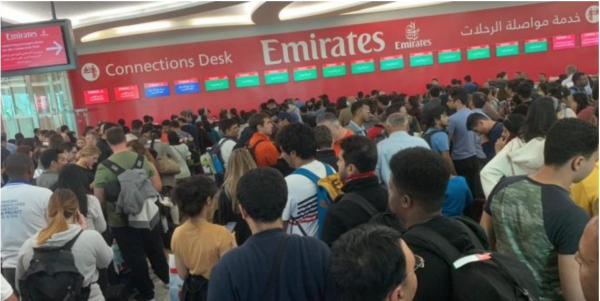Customer CARE when things go bad: how Emirates got it wrong
Guest post by Prasad Narasimhan, Managing Partner based in Bangalore India, and a specialist in Brand Experience.
They say that a man’s true character only reveals itself in tough times. The same can be said for brands. Just as brands plan for good times, they must also design ‘service recovery’ experiences for when things go bad. A recent painful experience with Emirates Airlines suggests that the brand misses such a process.
On the 10th of January a flash flood hit the airline’s airport hub in Dubai sending systems into chaos. Thousands of passengers, including me, were stranded, having missed our connections because incoming flights were delayed or cancelled. A series of incredibly bad experiences with Emirates followed. In hours, livid social media posts and the bitter aftertaste of terrible service undermined years of brand building investment.

Brand AND deliver
Maya Angelou said, “People will forget what you say but never forget how you made them feel”. Great companies don’t just spend on communication that say things to us, they also design and deliver distinctive experiences that makes us feel the brand. We call these branded interventions ‘service signatures’ and when done well they become part of the a company’s culture, and indeed, lore. Virgin Atlantic is a great example of ‘baking in’ such remarkability at each stage of the customer journey as I posted on here.

CARE when things go bad
Brands can’t predict external shocks such as the flash flood in Dubai airport. But they can decide how they show up when things get screwed up. We use an approach called CARE to help service brands design a service recovery exprience . Done well, service recovery can actually enhance peoples’ feelings about a brand. A Virgin example shared in a brandgym workshop was when a cabin crew member spilt coffee on a passenger’s jacket, offering to have the jacket cleaned and couriered to the customer’s hotel.
Below I illustrate the CARE approach using my Emirates experience as a bad example!
1. Communicate
This is the bare minimum. Brands can reach out and tell consumers what went wrong & why. And what they are planning to do about it. Consumers are generally forgiving and appreciate this little effort. It helps them plan, rationalize and minimize the disruption in their lives. The staff at Emirates chose not to communicate through the entire day, even as passengers were getting extremely worried and irate. Instead, they hid behind a stolid wall of silence, dismissively fobbing off questions. No announcements were made even as thousands of passengers were packed like sardines, standing for over 16 hours.
2. Acknowledge
Accept the problem. Acknowledge the pain caused. Apologize (when warranted). Above all, be authentic. Consumers don’t deserve insincerity from a brand that lands them in trouble. Emirates brazened this episode out for over 24 hours. Each time passengers expressed their anger, Emirates staff simply shut themselves out, often even walking away saying they’d be back when things calmed down. No hint of acknowledgement. They simply didn’t care. Not even when an elderly passenger collapsed & fainted out of sheer exhaustion.
3. Retrieve
Bad situations offer great opportunities to convert negatives into positives. Brands with their backs against the wall need to work extra hard to retrieve the situation they created. Emirates’ response was ridiculously shoddy, let alone any attempt at retrieval. They responded to over 1,000 passengers with staff present in just 4-5 counters (of the 18 available) across the day. And rebuffed passengers who demanded more staff with callous statements like “You do your job & stand in the queue, we’ll do ours”.
4. Empathize
This is about feeling for the customer, her pain. Most people had to stand for over 12-14 hours in a packed enclosure with no place to even squat on the floor. There were no restaurants accessible, and people didn’t want to leave their places even to go to the bathroom because of the chaos. All Emirates did was send some carts every 4 hours with some water and occasionally, muffins. No words. Not a shred of empathy, let alone care or kindness.
In conclusion, service brand should plan how to CARE for their customers when things go wrong, not only when they go right. In the case of Emirates, a brand that spent $20million on an ad campaign with Jennifer Anniston claiming ‘Hello Tomorrow’ was not even ready for today! (1)
Only time will tell how this will impact their brand, but our recommendation would be for Emirates to take some of that massive ad budget and spend it on designing service signatures to help with service recovery. Look out for an upcoming post with tips on tricks on how to brand and deliver.
(1) https://www.businessinsider.com/emirates-launches-20-million-campaign-starring-jennifer-aniston-2015-10?r=US&IR=T


